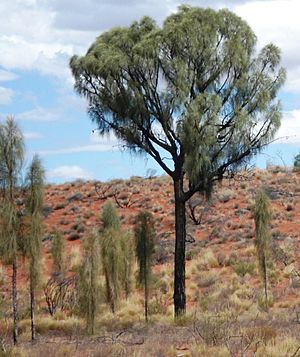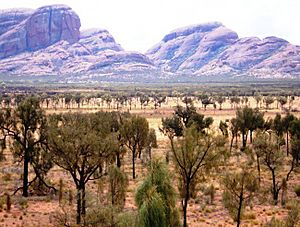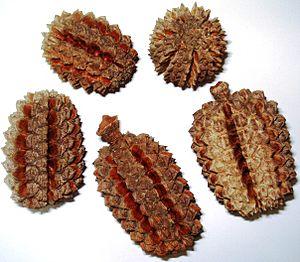Desert oak facts for kids
Quick facts for kids Desert oak |
|
|---|---|
 |
|
| Scientific classification | |
| Genus: |
Allocasuarina
|
| Species: |
decaisneana
|

The desert oak (also known as Allocasuarina decaisneana) is a special tree. It grows slowly in the dry desert areas of Northern Territory, South Australia, and Western Australia. The Anangu people, who are Indigenous Australians, call this tree kurkara.
Contents
What is a Desert Oak?
This tree is usually about 10 to 16 metres (33 to 52 feet) tall. Some can even reach 20 metres (66 feet) high! It can spread out 3 to 8 metres (10 to 26 feet wide).
Young desert oaks look different from older ones. Young trees have a thin trunk and feathery, grey-green branches. As they get older, their branches spread out, and their leaves become bushier. This tree is the only one of its kind found in Central Australia. Its large, cylinder-shaped cones are the biggest in its plant family.
The bark of the desert oak looks like cork and has deep grooves. This special bark helps protect the tree from bushfires.
Special "Leaves" and Roots
Instead of flat leaves, the desert oak has long, jointed branchlets. These are called cladodes. They look a bit like olive green pine needles. Each "needle" is made of thin, striped parts. These parts are actually tiny leaf stalks, connected by small rings. Each ring has tiny projections, which are the tree's real, tiny leaves.
These cladodes do the same job as leaves, but they are much better at saving water. When the cladodes fall off, they create a thick mat around the tree's base. This mat stops other plants from growing nearby. It also helps the desert oak get all the water and nutrients it needs.
The roots of the desert oak have special bumps called nodules. These nodules contain tiny bacteria that help the tree get nitrogen from the soil. This allows the tree to grow well even in sandy soils with few nutrients. When the tree is young, it grows a very long main root called a tap-root. This tap-root can go deeper than 10 metres (33 feet) to find water underground.
Flowers and Cones
Desert oaks usually bloom between March and June. Their flowers are small and fluffy, appearing in shades of red or brown. After the flowers, the tree grows its unique seed cones. These cones are shaped like cylinders and can be up to 10 centimetres (4 inches) long. This makes them much larger than the cones of other trees in the Allocasuarina family.
It can be tricky to grow desert oaks from seeds outside their natural home. Even if a fire burns the tree's branches, it usually doesn't kill the whole tree. Desert oaks are also very good at handling frost and long periods without rain.
Where Desert Oaks Grow
You can often find desert oaks growing in low areas between sand dunes. They grow best in deep red sand. These trees are found in the deserts of central Western Australia, the southern part of the Northern Territory, and northern South Australia. Often, the desert oak is the only tree you will see in these areas. The main type of plant around them is usually a spiky grass called spinifex.
How the Desert Oak Got its Name
The desert oak was first officially described in 1858 by a botanist named Ferdinand von Mueller. He called it Casuarina decaisneana. Later, in 1982, another botanist, Lawrence Alexander Sidney Johnson, changed its name to Allocasuarina decaisneana.
The name decaisneana honours a Belgian botanist named Joseph Decaisne. Interestingly, he never visited Australia or saw the desert oak tree in person!
Uses of the Desert Oak
The desert oak was very important to Indigenous Australian peoples. They used the trees as a source of water. Sometimes, water could be collected from hollows in the tree. They could also break off sections of the tree's surface roots. By holding the root upright or sucking directly from it, they could get drinkable water.
Indigenous Australians also used the tree's hard wood to make tools. They crafted boomerangs, shields, and clubs from it. A boomerang made from Allocasuarina wood was found in South Australia. It is an amazing 10,000 years old!
Desert Oak in Culture
The Aboriginal community of Oak Valley in South Australia is named after this tree. This community was started in 1985 for the Anangu people. They had to move from their traditional lands near Maralinga after nuclear weapons tests.
- John W. Wrigley and Murray Fagg (1997). Australian Native Plants. 4th edition, Reed.
See also
 In Spanish: Allocasuarina decaisneana para niños
In Spanish: Allocasuarina decaisneana para niños



